Dominant Factor Affecting to Intention of Nursing Students toward Basic Life Support (BLS) Effort: Using Theory of Planned Behavior Approach
DOI:
https://doi.org/10.21776/ub.jik.2022.010.01.2Keywords:
Dominant factor, Intention, Nursing students, Balic Life Support, Theory of Planned BehaviorAbstract
The less intention of nursing students toward Basic Life Support (BLS) effort could affect less quality of basic life support performed by nursing students. The study aimed to analyze the dominant factor affecting the intention of nursing students toward basic life effort using the theory of planned behavior approach. The samples were 100 respondents who met inclusion criteria using the purposive sampling technique. The instrument was a self-administered questionnaire that consisted of the variables from the theory of planned behavior. The data analysis using logistic regression. The result showed that attitude was the dominant factor affecting to intention (p=0.000; OR=47.175). followed by subjective norm (p=0.011; OR=19.002) and perceived behavioral control (PBC) (p=2.344; OR=10.428). Nursing students' intention could be optimized through the effort to enhance attitude toward basic life support. enhancing external support (supervisors and nursing student peers). and enhancing perception about the function of self-control to utilize the resources (perceived behavioral control).
References
- Ajzen I. (2012). The Theory of Planned Behavior. In P. A. M. Lange, A. W. Kruglanski & E. T. Higgins (Eds.). Handbook of Theories of Social psychology (1st ed 1, pp. 438-459). London, UK: Sage.
- Arafat, Y., & Ibrahim, M. (2018). Social and Administrative Aspects of Pharmacy in Low and Middle Income Countries: The Use of Measurements and Health Behavioral Models to Improve Medication Adherence. Academic Press.
- Chen, C.L., Tang, J.S., Lai, M.K., Hung, C.H., Hsieh, H.M., Yang, H.L., & Chuang, C.C. (2017). Factors Influencing Medical Saff’s Intentions to Implement Family- Witnessed Cardiopulmonary Resuscitation: A Cross-Sectional, Multihospital Survey. Eur J Cardiovasc Nurs, 16(6), 492-501.
- Chockalingam, P., & Wilde, A.A. (2014). Inherited arrhythmia syndromes leading to sudden cardiac death in the young. A global update and an Indian perspective. Indian Heart J, 66(1), 49-57.
- Cooke, R., Dahdah, M., Norman, P., & French, D. (2016). How Well Does The Theory of Planned Behaviour Predict Alcohol Consumption?. Health Psychol. Rev, 10, 148-167.
- El Sayed, M., Al Assaad, R., Aad, Y.A., Gharios, N., Refear, M.M., & Tamim, H. (2017). Measuring the impact of emergency medical services (EMS) on out-of-hospital cardiac arrest survival in a developing country; a key metric for EMS systems’ performance. Medicine (Baltimore), 96(11), e7570-e7578.
- Hoffmann, T., Bennett, S., & Del Mar, C. (2013). Evidence-based Practice Across the Health Professions. 2nd ed. Churchill Living Stone Australia: Elsevier.
- Javadi, M., Kadkhodaee, M., aghoubi, M., Maroufi, M., & Shams, A. (2021). Applying Theory of Planned Behavior to predicting of patient Safety behaviors of Nurses. Ma Soc Med, 25(1), 52-55.
- Kardong-Edgren, S.E., Oermann, M.H., & Odom-Maryon, T. (2010). Comparison of two instructional modalities for nursing student CPR skill acquisition. Resuscitation, 81(9), 1019–1024.
- Kardong-Edgren,S., Oermann, M.H., & Odom-Maryon, T. (2012). Findings from a nursing student CPR study: Implications for staff development educators. J. Nurses Staff Dev, 28(6), 9–15.
- Lapkin, s., Jones, T., & Giligan C. (2015). Using the Theory of Planned Behaviour to Examine Health Professional Students' Behavioural Intentions in Relation to Medication Safety and Collaborative Practice. Nurse Education Today, 35, 935-940.
- Link, C.J., Aufderheide, T.P., & Niskanen, R.A. (2011). Take Heart America: a comprehensive, community-wide, systems-based approach to the treatment of cardiac arrest. Crit Care Med, 39(6), 26-33.
- Magid, K.H., Ranney, M.L., & Risica, P.M. (2021). Using the theory of Planned Behavior to understand intentions to perform bystander CPR among college students. Journal of American College Health, 69(1), 47-52.
- McDermott et al. (2015). The Theory of Planned Behaviour and Dietary Patterns: a Systematic Review and Meta-Analysis. Prev. Med, 81, 150-156.
- Neumar, R.W., Shuster, M., Callaway, C.W., Gent, L.M., Atkins, D.L., Bhanji, F., Brooks, S.C., de Caen, A.R., Donnino, M.W., Ferrer, J.M., Kleinman, M.E., Kronick, S.L., Lavonas, E.J., Link, M.S., Mancini, M.E., Morrison, L.J., O'Connor, R.E., Samson, R.A., Schexnayder, S.M., Singletary, E.M., Sinz, E.H., Travers, A.H., Wyckoff, M.H., & Hazinski, M.F. (2015). Part 1: Executive Summary 2015 American Heart Association Guidelines update for cardiopulmonary resuscitation and emergency cardiovascular care. Circulation, 18(2), S315-67.
- Panchal et al. (2015). An "Intention-Focused" Paradigm for Improving Bystander CPR Performance. Resuscitation, 88(6), 48-51.
- Perkins, G.D., Handley, A.J., Koster, R.W., Castrén, M., Smyth, M.A., Olasveengen,T., Monsieurs, K.G., Raffay, V., Gräsner, J.T., Wenzel, V., Ristagno, G., & Soar, J. (2015). Adult basic life support and automated external defibrillation section Collaborators. European Resuscitation Council Guidelines for Resuscitation 2015: Section 2. Adult basic life support and automated external defibrillation. Resuscitation, 95(6), 81-99.
- Shi, W., & Hall, B.J. (2021). Help-seeking intention among Chinese college students exposed to a natural disaster: an application of an extended theory of planned behavior (E-TPB). Soc Psychiatry Psychiatr Epidemiol, 56(7), 1273-1282.
- Smith, A. (2015). Attitude, Subjective Norm, and Perceived Behavioral Control as Indicators for Nurse Educators' Intention to Use Critical Thinking Teaching Strategies: a Structural Equation Model Analysis. Michigan: Andrews University.
- Talbot, A., Dorrian, J., & Chapman, J. (2015). Using the Theory of Planned Behaviour to examine enrolled nursing students' intention to care for patients with alcohol dependence: A survey study. Nurse Education Today, 35, 1054-1061.
- Wati, S., Wihastuti, T., & Nasution, T. (2017). Analysis of Factors Affecting Behavioral intention of Nursing Student as Bystander Cardiopulmonary Resuscitation on Handling Out of Hospital Cardiac Arrest (OHCA) In Malang. Jurnal Ilmu keperawatan, 5(2), 230-239.
- Wati, S. G., Wihastuti, T. A., & Nasution, T. H. (2021). Application Of The Theory Of Planned Behavior To Identify Nursing Student’s Intention To Be A Bystander Cardiopulmonary Resuscitation. NurseLine Journal, 6(1), 24-30.
Downloads
Published
How to Cite
License
Copyright (c) 2022 Journal of Nursing Science Update

This work is licensed under a Creative Commons Attribution-NonCommercial 4.0 International License.
Authors published in this journal agree to the following terms:
1. The copyright of the received article shall be assigned to the journal as the publisher of the journal. The intended copyright includes the right to publish the article in various forms (including reprints). The journal maintains the publishing rights to the published articles.
2. Authors may enter into separate additional contractual agreements for the non-exclusive distribution of the published journal version of the work (for example, posting it to an institutional repository or publishing it in a book), with acknowledgment of their initial publication in this journal.
3. Authors are permitted and encouraged to post their work online (e.g. in an Institutional Repository or on their website) before and during the submission process, as this can result in a productive exchange, as well as earlier and larger citations of the published work.
4. Articles and all related material published are distributed under Creative Commons Attribution-NonCommercial 4.0 International License or CC BY-NC 4.0 license.
JNSU is licensed under a Creative Commons Attribution-NonCommercial 4.0 International License or CC BY-NC 4.0 license.
Most read articles by the same author(s)
- Yusron Amin, Ahsan Ahsan, Tony Suharsono, FACTOR ANALYSIS OF HYPOGLICEMIA LEVEL IN EMERGENCY DEPARTMENT OF BLAMBANGAN AND GENTENG GENERAL HOSPITAL BANYUWANGI , Journal of Nursing Science Update (JNSU): Vol. 5 No. 2 (2017)






























